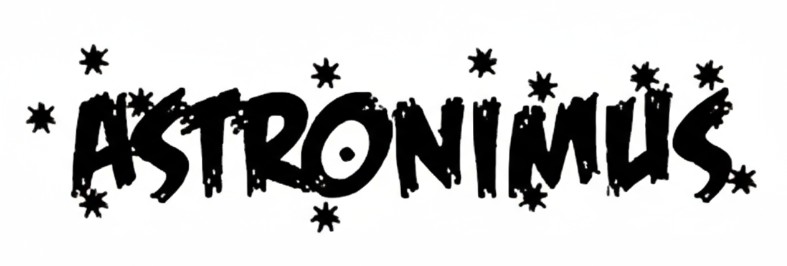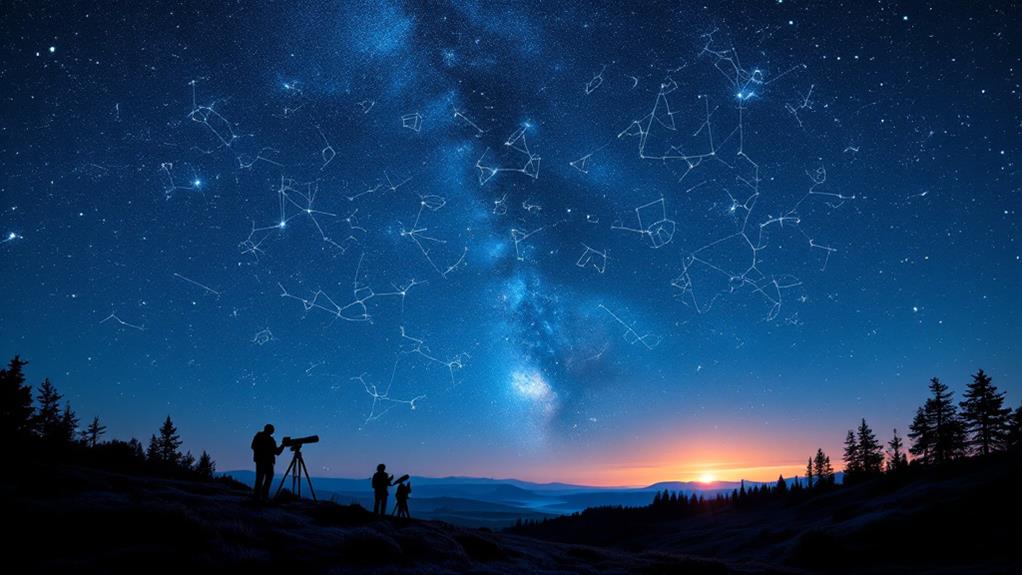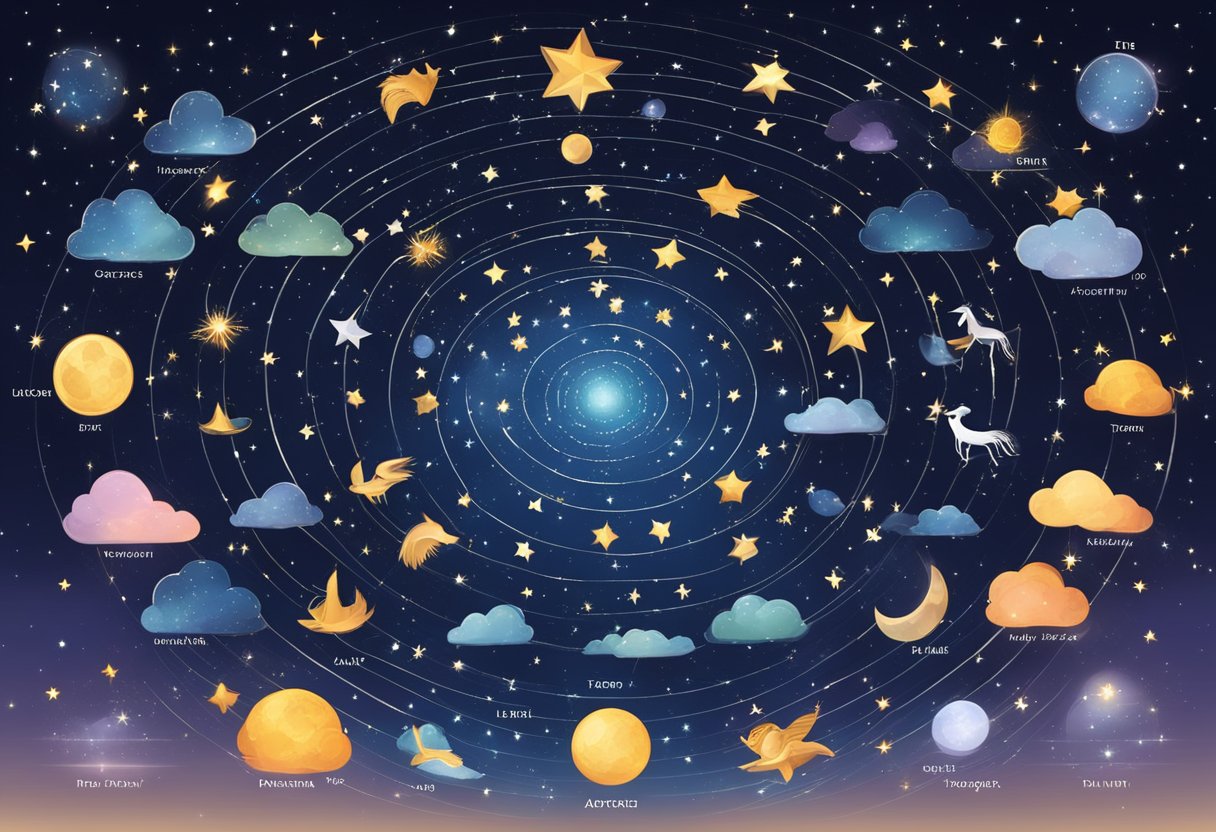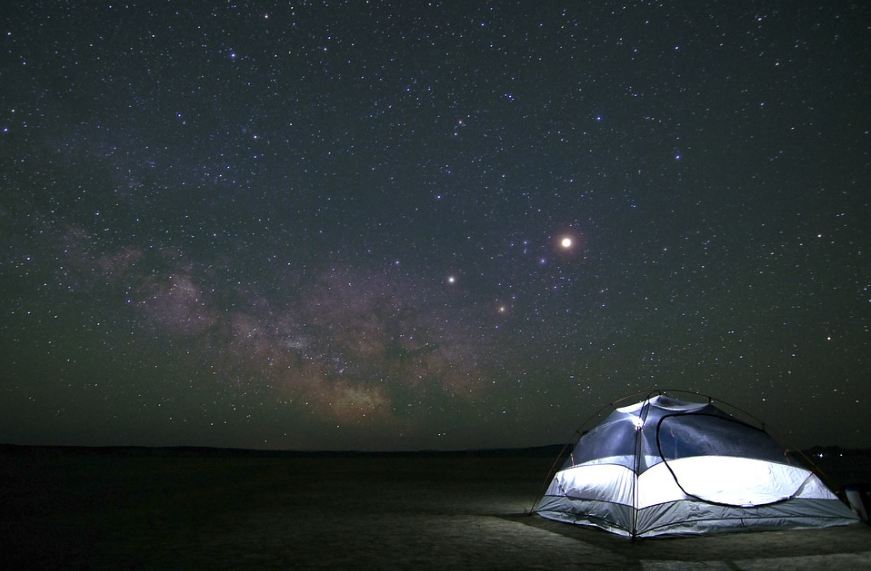How Were the Constellations Named?
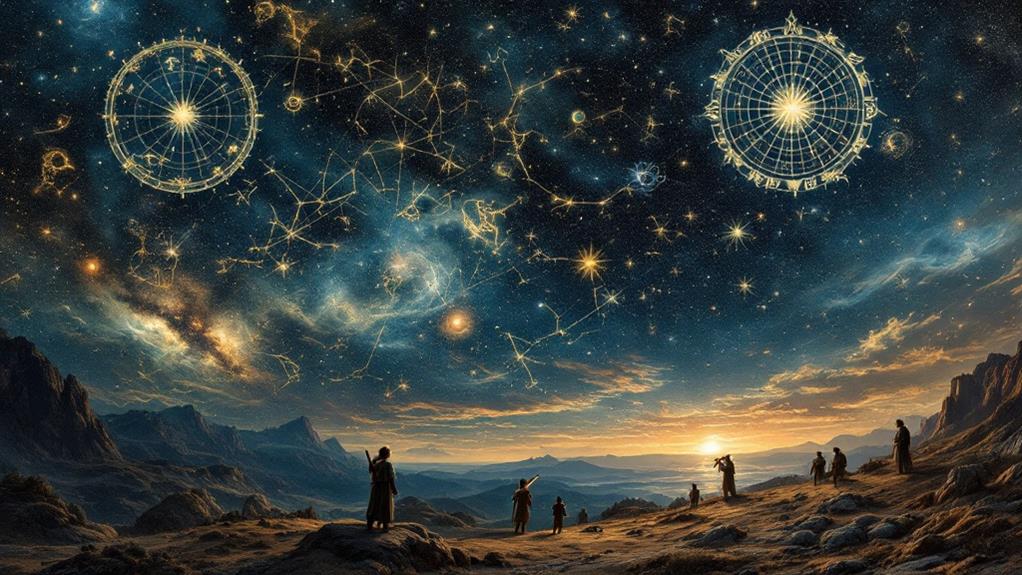
Constellations were named by various ancient civilizations, with many originating from Mesopotamian, Greek, and Roman cultures. You'll find that most constellation names reflect mythological figures, animals, and cultural objects. Early astronomers and stargazers associated celestial patterns with stories and legends, creating a rich quilt of sky lore. Over time, these names were adopted, adapted, and standardized by different societies. While Western astronomy dominates modern star charts, diverse cultural interpretations of the night sky exist worldwide. Today's 88 officially recognized constellations blend ancient storytelling with scientific precision, offering a fascinating glimpse into humanity's enduring connection to the cosmos.
Ancient Origins of Constellation Names
Many constellation names have roots stretching back thousands of years to ancient civilizations. You'll find that these celestial patterns have been recognized and named by various cultures throughout history, each with their own unique standpoint on the night sky.
Ancient sky lore played an essential role in shaping the constellations we are familiar with today. Mesopotamian astronomers, for instance, were among the first to identify and name star patterns, with their observations dating back to around 3000 BCE. These early stargazers often associated celestial groupings with mythological figures, animals, and objects important to their cultures.
Greek and Roman civilizations later adopted and adapted many of these constellations, infusing them with their own myths and legends. You'll recognize names like Orion, Ursa Major, and Cassiopeia from these Greco-Roman traditions. As celestial traditions spread and evolved, different cultures developed their own interpretations of the night sky. Chinese, Indian, and Native American astronomers, among others, created distinct constellation systems that reflected their unique worldviews and cultural beliefs. Today, the 88 officially recognized constellations are a blend of these ancient traditions and more recent additions from European astronomers.
Greek and Roman Mythological Influences
Greek and Roman mythology greatly shaped the constellation names we use today. You'll find that many constellations bear the names of heroic figures and divine representations from these ancient cultures. For example, Orion the Hunter, one of the most recognizable constellations, comes from Greek mythology. It's said to represent a mighty hunter placed among the stars by Zeus. Incorporation of Babylonian knowledge into Greek astronomical and astrological traditions also influenced the constellation naming conventions. You'll also encounter constellations named after other mythological characters like Perseus, Andromeda, and Cassiopeia. These celestial patterns often tell stories of epic adventures, tragic love, and godly interventions. The zodiac constellations, such as Leo, Taurus, and Gemini, are particularly steeped in Greco-Roman lore. Roman astronomers largely adopted Greek constellation names, sometimes tweaking them to fit their own mythological interpretations. For instance, the Greek Kronos became the Roman Saturn. This blending of cultures resulted in a rich fabric of star lore that's still reflected in our night sky today.
Cultural Variations in Star Patterns
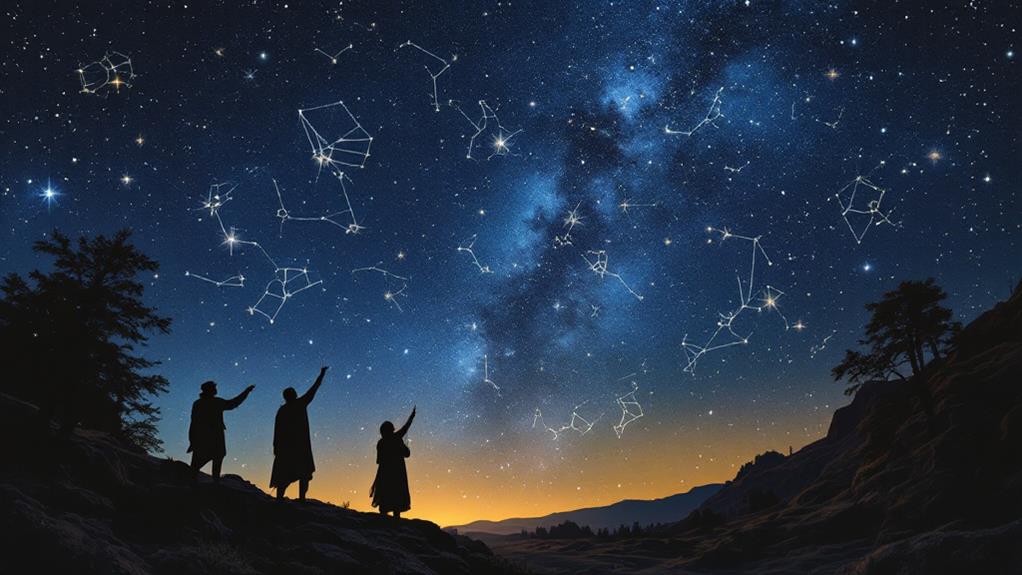
While Greek and Roman mythology heavily influenced Western constellation names, you'll find that different cultures around the world have come up with their own unique star patterns and stories. These diverse celestial traditions reflect the rich tapestry of human imagination and cultural viewpoints.
Indigenous star knowledge often differs substantially from Western astronomy. For example, many Aboriginal Australian cultures see the dark spaces between stars as important celestial features, rather than focusing solely on the bright stars themselves. In Chinese astronomy, you'll encounter constellations like the celestial bureaucracy, mirroring earthly governmental structures.
Some enthralling examples of cultural variations in star patterns include:
- The Inca saw the Milky Way as a celestial river, with dark cloud formations representing animals drinking from it
- Polynesian navigators used star paths to guide their oceanic voyages, viewing the night sky as a cosmic map
- Native American tribes often saw constellations as animals important to their daily lives and spiritual beliefs
These diverse interpretations of the night sky highlight how our understanding of the cosmos is deeply intertwined with our cultural heritage and worldview. By exploring these varied perspectives, you'll gain a richer appreciation for humanity's enduring fascination with the stars.
Early Astronomers and Celestial Mapping
Ancient civilizations laid the groundwork for modern celestial mapping through detailed observation and record-keeping. Early astronomers in Mesopotamia, Egypt, and China developed sophisticated astronomical observation methods, tracking celestial bodies' movements and positions over time. They used simple tools like gnomons and astrolabes to measure the stars' angles and elevations.
You'll find that these early stargazers created pioneering celestial charts, documenting the positions of stars and planets relative to Earth. The Babylonians, for instance, divided the night sky into 12 sections, corresponding to the zodiac constellations we know today. Greek astronomers, like Ptolemy, built upon this knowledge, creating extensive star catalogs and refining celestial mapping techniques.
In the Islamic Golden Age, astronomers like Al-Sufi further advanced celestial cartography, combining Greek and Arabic star names and improving the accuracy of star positions. These early efforts in mapping the sky laid the foundation for modern astronomy. As you investigate the night sky today, you're benefiting from centuries of thorough observation and documentation by these pioneering astronomers, who helped shape our understanding of the cosmos.
Modern Constellations and Naming Conventions

Today's constellation names and boundaries stem from centuries of astronomical tradition and modern standardization efforts. In 1922, the International Astronomical Union (IAU) officially recognized 88 constellations, establishing clear borders for each one. These modern constellations incorporate ancient patterns and newer additions, creating a thorough map of the night sky.
You'll find that many constellation names still reflect their ancient origins, with mythological figures and animals dominating the celestial landscape. However, the scientific community has adapted these traditional patterns for practical use in celestial positioning techniques and star classification systems. Astronomers now use constellations as reference points to locate and catalog celestial objects.
Modern naming conventions for newly discovered stars and celestial bodies follow strict guidelines set by the IAU. These rules guarantee consistency and avoid confusion in the scientific community. When you gaze at the night sky, you're looking at a blend of ancient storytelling and modern scientific precision.
- Orion's belt glinting against the inky darkness
- The Big Dipper's familiar shape pointing to Polaris, the North Star
- Scorpius' curving tail stretching across the summer sky
Scientific Instruments as Constellation Inspirations
During the Age of Enlightenment, astronomers began naming constellations after scientific instruments. This shift reflected the era's emphasis on scientific progress and discovery. You'll find constellations like Microscopium (the Microscope), Telescopium (the Telescope), and Fornax (the Furnace) among these newer additions to the night sky.
The introduction of scientific instruments as constellation inspirations wasn't just a nod to technology; it also represented a change in how astronomers viewed celestial imagery. Instead of relying solely on mythological figures or animals, they now incorporated tools that were essential to their work. This change in viewpoint aligned with advancements in telescope design and other scientific apparatus.
You can spot these instrument-inspired constellations primarily in the southern hemisphere, where many new constellations were added during this period. While they may not be as visually striking or easy to identify as their ancient counterparts, these constellations serve as a chronicle to humanity's scientific progress. They remind us of the tools that have expanded our understanding of the universe and continue to shape our exploration of the cosmos.
Animal-Inspired Constellations
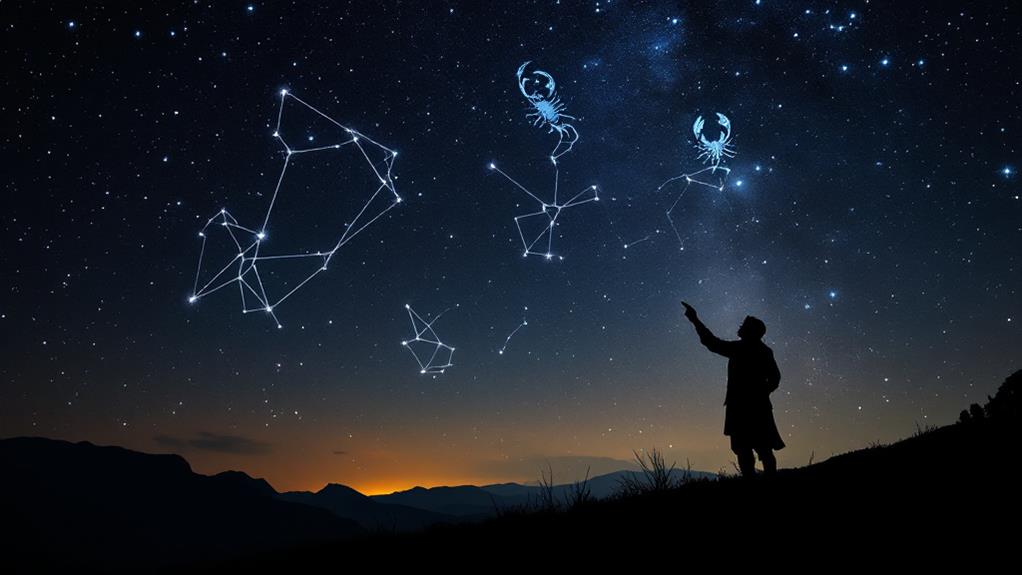
While scientific instruments inspired some constellations, animals have played a significant role in celestial naming since ancient times. You'll find that animal-inspired constellations are among the oldest and most recognizable patterns in the night sky. Celestial zoomorphism, the practice of associating animal forms with star patterns, has been a common thread across cultures worldwide.
Animal symbolism in constellations often reflected the importance of certain creatures in ancient societies. You might recognize some of these well-known animal constellations:
- Ursa Major (Great Bear): Resembling a large dipper, this constellation dominates the northern sky
- Leo (Lion): A majestic feline figure visible in spring and early summer
- Scorpius (Scorpion): A striking scorpion shape with a curved tail, prominent in summer nights
These animal-inspired patterns helped early stargazers traverse the night sky and track seasonal changes. They also served as powerful storytelling tools, with each constellation often tied to myths and legends. As you gaze at the stars, you're connecting with a rich tradition of animal imagery that has enchanted humanity for millennia.
Legacy and Significance Today
The legacy of constellation naming lives on in modern astronomy and popular culture. You'll find that our celestial heritage continues to shape how we perceive and interact with the night sky. Modern astronomers still use many of the traditional constellation names for navigation and identification, preserving ancient wisdom in contemporary science.
In everyday life, you'll encounter constellations in various forms. From horoscopes to corporate logos, these star patterns maintain their cultural symbolism. They've inspired countless works of art, literature, and music, connecting us to our ancestors' imaginations.
Constellations also play an essential role in education. They serve as memorable teaching tools, helping students learn about celestial mechanics, mythology, and history. You might use them to spark curiosity about space exploration or to discuss how different cultures interpret the same sky.
Furthermore, constellations contribute to dark sky preservation efforts. As you become more aware of these celestial patterns, you're likely to develop a deeper appreciation for the night sky, potentially supporting initiatives to reduce light pollution and protect our view of the stars.
Frequently Asked Questions
Can New Constellations Be Officially Recognized and Named Today?
Yes, new constellations can be officially recognized and named today. You'll find that identifying unofficial constellations is often done by amateur astronomers and enthusiasts. However, for a constellation to become official, it requires recognizing constellations through global cooperation. The International Astronomical Union (IAU) is the authority on this matter. They'll consider proposals for new constellations, but it's a rare occurrence. The last official additions were made in 1930, so it's not a common practice in modern times.
How Many Total Constellations Are There in the Night Sky?
You might be surprised to learn that there are exactly 88 officially recognized constellations visible from Earth. This constellation count was established by the International Astronomical Union in 1922. While you can't see all of them from one location, these 88 patterns cover the entire celestial sphere. They're divided between the northern and southern hemispheres, with some visible year-round and others only during certain seasons. So next time you're stargazing, you'll know there's a finite number to investigate!
Are Constellation Names the Same in All Languages?
You'll find that constellation names aren't the same in all languages. Constellation names vary among cultures, reflecting diverse mythologies and traditions. While some constellations are widely recognized, you'll encounter regional differences in constellation recognition. Different civilizations have identified unique patterns in the night sky, assigning their own names and stories to star groups. As you plunge into astronomy across cultures, you'll uncover a rich mosaic of celestial interpretations that showcase humanity's universal fascination with the stars.
Do Other Planets Have Constellations Visible From Their Surface?
Yes, you'd see constellations from other planets, but they'd look different from Earth's. Your viewpoint would change, altering familiar star patterns. You might spot new groupings unique to that planet's perspective. Remember, constellations are human inventions, influenced by cultural viewpoints. If life exists elsewhere, they'd likely create their own star patterns, reflecting their world's vantage point and cultural background. So, while stars are universal, constellations are a product of our earthly imagination and position.
Can Constellations Change Shape Over Time Due to Stellar Movement?
Yes, constellations can change shape over time due to stellar movement. You'll notice these changes happen gradually, as stars in a constellation move at different speeds and directions. This phenomenon, called stellar drift, occurs over millennia. While the changes aren't noticeable in your lifetime, they'll eventually alter the apparent constellation shapes you see in the night sky. Over thousands of years, familiar patterns will slowly evolve into new configurations.
